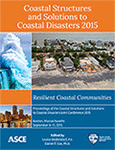Coastal Structures and Solutions to Coastal Disasters Joint Conference 2015
Performance Comparison of Dune Erosion Models Relative to Storm Erosion Measurements on Pacific Coast Beaches
Publication: Coastal Structures and Solutions to Coastal Disasters 2015: Resilient Coastal Communities
ABSTRACT
Primary frontal dunes at sandy shores are essential features to mitigate flooding and erosion damage to coastal properties and infrastructure by coastal storms. Projecting the geomorphologic response of the beach and dune profile caused by extreme storms is required to establish risk levels to upland improvements. Procedures are available to predict dune erosion, and detailed examination of their performance would be valuable in selecting the appropriate tool for given storm and beach characteristics. Two geometric models (the Kriebel and Dean Method; the McDougal, Komar, and MacArthur method), one analytical model (the Larson, Erikson, and Hanson wave impact model), and two process-based models (SBEACH and XBeach) were applied with data for known storms to surveyed beach and dune profiles along a 10.6 km (6.6 mile) reach of shoreline south of the Grays Harbor Entrance in Washington State. To compare performance of these methods in predicting beach and dune changes in severe storms, locations were selected within this reach that demonstrate a range of morphologies and local sediment budgets. Results of applying the dune erosion models illustrate the predictive accuracy of the geometric models, for which few input adjustments are available, and the range of adjustments that are required for the process-based models to optimally represent measured beach and dune modifications. This paper presents pre- and post-storm profiles of the beach and dune at both accreting and non-accreting locations, details of the storm waves and water levels bracketed by the surveys, and an evaluation of the models’ predictive capabilities.
Get full access to this article
View all available purchase options and get full access to this chapter.
REFERENCES
Deltares (2014). Delft3D-FLOW, Simulation of Multi-Dimensional Hydrodynamic Flows and Transport Phenomena, Including Sediments, User Manual, Hydro-Morphodynamics, Deltares, Delft, The Netherlands.
Federal Emergency Management Agency (2005). Guidelines for Coastal Flood Hazard Analysis and Mapping of the Pacific Coast of the United States. Prepared for FEMA by Northwest Hydraulic Consultants. FEMA Region 9, Oakland, CA.
Kriebel, D. and Dean, R. (1993). “Convolution Method for Time-Dependent Beach-Profile Response.” J. Waterway, Port, Coastal, Ocean Eng., 119(2), 204–226.
Larson, Magnus and Nicholas C. Kraus (1989). SBEACH Report 1: Empirical Foundation and Model Development. Technical Report CERC-89-9. U.S. Army Engineer Coastal Engineering Research Center, 3909 Halls Ferry Road, Vicksburg, MS 39180.
Larson, Magnus, Li Erikson, and Hans Hanson (2004). “An Analytical Model to Predict Dune Erosion Due to Wave Impact.” Coastal Engineering 51 (2004) p. 675 – 696.
Mull, Jeremy and Ruggiero, Peter (2014). Estimating Storm-Induced Dune Erosion and Overtopping along U.S. West Coast Beaches, Journal of Coastal Research, 30(6), 1173–1187. Coconut Creek (Florida), ISSN.
National Oceanographic and Atmospheric Administration (2013). Center for Operational Oceanographic Products and Services, http://tidesandcurrents.noaa.gov/, October 15, 2013, accessed October 26, 2015.
National Oceanographic and Atmospheric Administration (2014). Storm Surge Overview, http://www.nhc.noaa.gov/surge/, September 5, 2014, accessed October 26, 2015.
National Oceanographic and Atmospheric Administration (2015a). NOAA ENC Direct to GIS, http://encdirect.noaa.gov/ENC_Direct/encdirect_download.html, accessed January, 2, 2015.
National Oceanographic and Atmospheric Administration (2015b). NOS Hydrographic Survey Data, http://www.ngdc.noaa.gov/mgg/bathymetry/hydro.html, accessed January, 2, 2015.
Roelvink, Dano, Ad Reniers, Ap van Dongeren, Jaap van Thiel de Vries, Jamie Lescinski, and Robert McCall (2010). XBEACH Model Description and Manual. Report of Unesco-IHE Insdtitute for Water Education, Deltares and Delft University of Technology, version 6, June 21, 2010.
Scripps Institute of Oceanography (2015). The Coastal Data Information Program, Scripps Institute of Oceanography Integrative Oceanography Division, http://cdip.ucsd.edu/, accessed October 26, 2015.
Strategic Alliance for Reduction Risk (STARR) - STARR - Region X Service Center (2013). STWAVE Modeling Methodology - Pacific and Grays Harbor Counties, Washington, STARR - Region X Service Center, Lynnwood, WA.
Washington State Department of Ecology (2012). Beach Morphology Monitoring Program Beach Profiles, http://www.ecy.wa.gov/programs/sea/swces/products/data.htm, accessed May 12, 2014.
Information & Authors
Information
Published In
Coastal Structures and Solutions to Coastal Disasters 2015: Resilient Coastal Communities
Pages: 98 - 110
Editors: Louise Wallendorf, U.S. Naval Academy and Daniel T. Cox, Ph.D., Oregon State University
ISBN (Online): 978-0-7844-8030-4
Copyright
© 2017 American Society of Civil Engineers.
History
Published online: Jul 11, 2017
Published in print: Jul 11, 2017
Authors
Metrics & Citations
Metrics
Citations
Download citation
If you have the appropriate software installed, you can download article citation data to the citation manager of your choice. Simply select your manager software from the list below and click Download.
